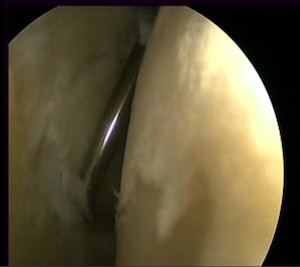
Normal cartilage 
Worn cartilage
What is shoulder arthritis?
Shoulder arthritis is a common joint disease caused by loss of the articular cartilage which lines the joint surfaces. In a normal joint, the cartilage is several millimetres thick and very slippery. This means that the joint surfaces can glide smoothly over one another. In an arthritic joint, the joint surfaces become rougher because of the loss of the cartilage. In severe cases, the cartilage may disappear completely so that the joint surface is reduced to bone against bone, resulting in pain, stiffness and crepitus (a grinding feeling).
A non-stick frying pan is a good analogy. In a new pan, the slippery teflon coating prevents anything from sticking. In an older pan where the teflon (the cartilage) has been gradually scraped away exposing the metal underneath (the bone), everything starts to catch.
What causes shoulder arthritis?
Most arthritis is caused by simple wear and tear. This is known as osteoarthritis. It becomes increasingly common with age, and most elderly people have arthritis to some degree. However no one really knows why some people develop more severe arthritis or at an earlier age. It is less common in the shoulder than in weight-bearing joints such as the hips or knees.
In some cases, arthritis may be caused by an old injury to the joint, particularly if there has been a fracture involving the joint surface.
In the shoulder, arthritis may also be caused by a large chronic tear of the rotator cuff tendons which destabilises the shoulder joint. Over time, this can damage the joint surfaces. This is known as cuff tear arthropathy.
What are the symptoms of shoulder arthritis?
The main symptoms of shoulder arthritis are pain and stiffness. Some people also describe a catching sensation or crepitus when they move their shoulder.
Pain is generally felt either deep inside or around the shoulder. In milder cases this may only be a dull ache after prolonged or heavier activities. With more severe arthritis, there may be a constant pain which is aggravated by any shoulder movement and which also affects sleep.
How do you diagnose shoulder arthritis?

A specialist can usually diagnose shoulder arthritis based on the pattern of symptoms and by examining your shoulder. However the diagnosis is then confirmed with a shoulder x-ray. This will typically show reduced joint space (because of cartilage loss). In more severe cases, there may be bony spurs, bone cysts or sometimes even bony erosion.
A CT-scan is sometimes also necessary to gain further information on the condition of the joint, particularly if one is considering a shoulder replacement
How do you manage shoulder arthritis
Many people with arthritis are able to manage their symptoms with simple measures such as activity modification and pain-killers. The general principle is to try and stay as active as possible whilst avoiding movements which are particularly painful. The NHS website offers good advice on living with arthritis. However if pain becomes excessive, then surgery in the form of a shoulder replacement is an option.